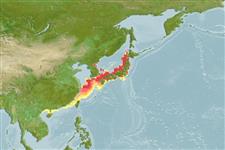Environment: milieu / climate zone / depth range / distribution range
Écologie
marin démersal; océanodrome (Ref. 51243). Temperate
Northwest Pacific: Japan and Korea.
Length at first maturity / Taille / Poids / Âge
Maturity: Lm ?, range 26 - ? cm
Max length : 43.0 cm TL mâle / non sexé; (Ref. 40637); poids max. publié: 1.2 kg (Ref. 40637)
Inhabit rocky shore areas. Juveniles associate with drifting seaweed (Ref. 12114, 12115). Feed on crabs and fishes (Ref. 9137). Viviparous (Ref. 34817).
Life cycle and mating behavior
Maturité | Reproduction | Frai | Œufs | Fécondité | Larves
Masuda, H., K. Amaoka, C. Araga, T. Uyeno and T. Yoshino, 1984. The fishes of the Japanese Archipelago. Vol. 1. Tokai University Press, Tokyo, Japan. 437 p. (text). (Ref. 559)
Statut dans la liste rouge de l'IUCN (Ref. 130435)
Menace pour l'homme
Harmless
Utilisations par l'homme
Plus d'informations
Taille/ÂgeCroissanceLongueur-poidsLongueur-longueurFréquences de longueursMorphométrieMorphologieLarvesDynamique des populations larvairesRecrutementAbondanceBRUVS
RéférencesAquacultureProfil d'aquacultureSouchesGénétiqueElectrophoresesHéritabilitéPathologiesTraitementNutrientsMass conversion
CollaborateursImagesStamps, Coins Misc.SonsCiguateraVitesseType de nageSurface branchialeOtolithesCerveauxVision
Outils
Articles particuliers
Télécharger en XML
Sources Internet
Estimates based on models
Preferred temperature (Ref.
123201): 3.9 - 20.4, mean 14.5 °C (based on 62 cells).
Phylogenetic diversity index (Ref.
82804): PD
50 = 0.5000 [Uniqueness, from 0.5 = low to 2.0 = high].
Bayesian length-weight: a=0.01413 (0.00919 - 0.02172), b=3.03 (2.90 - 3.16), in cm total length, based on LWR estimates for this species & Genus-body shape (Ref.
93245).
Niveau trophique (Ref.
69278): 4.3 ±0.4 se; based on diet studies.
Résilience (Ref.
120179): Faible, temps minimum de doublement de population : 4,5 à 14 années (Fec=12,000).
Fishing Vulnerability (Ref.
59153): Low to moderate vulnerability (33 of 100).
